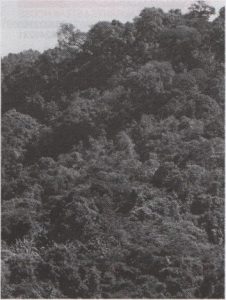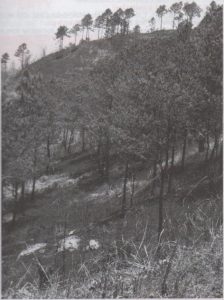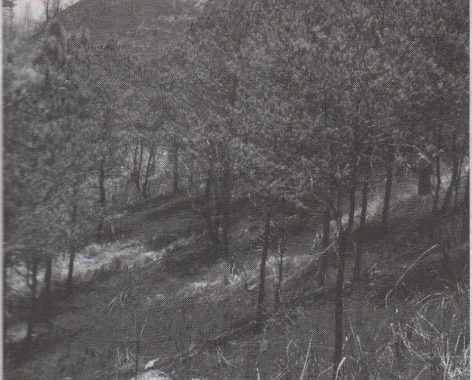Since 1994 Chiang Mai University’s Forest Restoration Unit (FORRU) has been developing techniques to restore tropical forests to degraded areas in northern Thailand.
FORRU has tested more than 400 local candidate tree species in the nursery and the field to determine the ones most suitable for restoring evergreen forests. From 1998-2007 FORRU and villagers in the Hmong village of Ban Mae Sa Mai in Doi Suthep-Pui National Park have planted more than 77,000 trees on 154 rai.
The Framework Species Method
FORRU’s framework species method relies on planting a minimum number of indigenous forest tree species for maximum ecological benefit. Framework species are selected for their potential to accelerate biodiversity recovery and enhance natural regeneration, creating a self-sustaining forest ecosystem from a single planting event. The characteristics of framework tree species include: high survival when planted out in deforested sites, rapid growth, dense, spreading crowns that shade out herbaceous weeds and flowering or fruiting, or provision of other resources, at a young age, to attract seed dispersing wildlife.
The method is working. With appropriate site preparation, planting and maintenance techniques, a survival rate of well over 90% is being achieved in the FORRU plots. Tree growth is rapid, with some species reaching seven metres just 18 months after planting. Research in the older field plots is yielding very promising results of forest recovery. Within ten years the variety of bird species has increased, from 30 to 87 species. Sites planted with 30 species are now recording 90 native natural forest regeneration.
In comparison, the degraded control plots have a thick cover of tall grasses and weeds with negligible forest recovery, showing that tree planting intervention is necessary to assist forest recovery in Doi Suthep- Pui National Park.
Environmental Benefits of Forest Restoration
Successfully restoring native forests to northern Thailand has many benefits, for example, restoring watersheds for maintaining water supplies in the dry season, stabilising eroding soil, providing rural communities with non-timber forest products, and protecting wildlife habitat to conserve biodiversity. The opportunity for these sites to also contribute to Thailand’s efforts in addressing climate change is significant.
FORRU Research Nursery
The main nursery at Doi Suthep-Pui National Park currently produces approximately 80,000 trees per year of around 200 species. As well as trees for experiments, the nursery provides trees to a host of other organisations in northern Thailand, and FORRU uses it to run training programmes for other forestry practitioners. This work is yielding results, with organisations in Thailand and other countries in the region improving their forest restoration techniques.
Snapshot of Ban Mae Sa Mai
Ban Mae Sa Mai is a Hmong village founded in 1967, and was included within the boundaries of Doi Suthep-Pui National Park in 1981. Today, Ban Mae Sa Mai consists of 190 households with a population of 1,700 making it the largest Hmong community in northern Thailand.
Despite being within the boundaries of a national park, Ban Mae Sa Mai is allowed to practice agriculture as they were settled before park establishment (a common occurrence throughout Thailand). Opium poppies were once grown there, but during the 1970s the practice was phased out and the villagers now grow corn, carrots, cabbages and lychees. More land was needed to grow these crops compared with opium, so more land was cleared. After some time, it became clear that forest clearance was taking its toll on the water supply. Other effects were increased erosion, landslides, drought, and wildlife extirpation.
Not only were the people of the area suffering from the effects of deforestation, the Ban Mae Sa Mai villagers developed a bad reputation for land management. So, in the early 1990s some village members established the Natural Resource and Environment Club of Ban Mae Sa Mai. This group encouraged other village members to use the forest resources sustainably. A set of penalties was established for tree telling, and there was increased protection of «ad the village and higher up the catchment, to ensure a clean and abundant water supply. Next to the village, a sacred forest was established, known as ‘Dong Seng’ forest, where rituals are carried out for village and forest protection.

Natural forest by Jenny Schabel
FORRU began working with the villagers in 1997 to construct a community nursery to produce local tree seedlings, train a nursery manager and provide funding for long-term tree and educational activities. FORRU supports tree monitoring and maintenance of the planted. The villagers also make fire breaks and organise west fire patrols.
A decade on, the planted plots provide the village with a catchment, wild animals with habitat, and FORRU with research sites to generate useful data. The results have given both the villagers and FORRU the encouragement to continue with forest restoration. The villagers of Ban Mae Sa Mai are also beginning to enjoy a positive reputation in their custodianship of the surrounding forests.
Citylife, as of January 2008, will contribute towards the planting of trees in Ban Mae Sa Mai on a 3.5 rai plot of land, offsetting all of its carbon emissions. For more information on FORRU please visit www.forru.org. To find out more about Citylife’s efforts and also to find out how YOU can offset your emissions please visit, www.chiangmaicitylife.com/carbonneutral.

Degraded forest
Did you know?
Tropical and sub-tropical forests cover only 16.8 percent of earth’s land area (FAO, 2001), yet they are home to more than half the planet’s plant and animal species (Uilson, 1988).
The Food and Agriculture Organisation of the United Nations estimates that natural tropical forests declined at a rate of 14.2 million hectares /approximately 0.7 percent per year), during 1990-2000, about the same rate of decline as during the previous decade ( FAO, 2001).
Thailand has lost more than half of its natural forest cover since 1961, and is left with about 24% cover. Despite a ban on commercial logging since 1989, forest loss continues.
